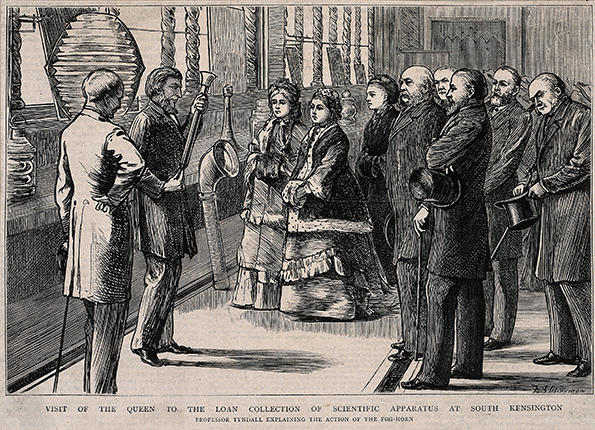The life of a physicist in Victorian Britain
DOI: 10.1063/PT.3.4186
John Tyndall’s death was nearly as remarkable as his life. The celebrated Irish physicist was known for his popular lectures on science, his daring climbs in the Swiss Alps, and his discovery of the phenomenon that we now know as the greenhouse effect. By the time he was in his early seventies, Tyndall suffered from severe insomnia and took a pair of medications to combat it: chloral and magnesia. But on 4 December 1893, his wife, Louisa, unfortunately confused the two bottles, which resulted in his death from chloral overdose 10 hours later.

John Tyndall demonstrates a foghorn to Queen Victoria and her entourage.
THEODORE BLAKE WIRGMAN, C. 1876; WELLCOME COLLECTION, CC BY 4.0

The grief-stricken Louisa set out to complete a “life and letters” volume in her husband’s honor, the usual way to commemorate a great thinker in Victorian Britain. Books such as Life and Letters of Thomas Henry Huxley (1900) and The Life and Letters of Faraday (1870) helped secure the legacies of other men of science. But Louisa was unable to complete the massive task of transcribing her husband’s correspondence before her own death in 1940. Despite fame during his lifetime, Tyndall faded into near-obscurity during the 20th century.

Now historian Roland Jackson has given Tyndall a weighty biography, The Ascent of John Tyndall: Victorian Scientist, Mountaineer, and Public Intellectual, that explores both Tyndall as a person and his place in Victorian science. The Ascent of John Tyndall chronicles the man’s varied and fascinating life using quotes from his journals and from his extensive correspondence. From those sources, Jackson provides a fine-grained account of Tyndall’s day-to-day life—his social circles, his financial situation, his romantic hopes and disappointments. Here is a typical passage: “Tyndall now terminated his employment with [Richard] Carter.… [He] believed that Carter owed him £257, but offered to settle for £200, of which £180 was left on account. Carter hosted a farewell dinner on 16th August, inviting [Thomas] Hirst and their colleague Jemmy Craven too. A few days later, Tyndall left for Manchester and from thence the south.”
Many readers will welcome the chance to immerse themselves in Tyndall’s world this way, but others may find themselves bogged down and skimming passages on topics that interest them less.
Tyndall came from humble origins. Born around 1820 in the Irish town of Leighlinbridge, he began his working life as a land surveyor. His interest in science blossomed in early adulthood, and after doctoral work in Germany, his research on diamagnetism eventually won him a position at London’s Royal Institution. There, Tyndall became known for his work on the mechanics of glacier formation, the properties of light, and the absorption and emission of radiant heat—including the earliest description of the greenhouse effect. His lively Friday Evening Discourses at the Royal Institution became a sought-after ticket for fashionable Londoners and, along with his popular writings, made him one of Britain’s most famous scientific figures. Tyndall was also a daring mountaineer; the chapter on his Alpine adventures—including a harrowing accident climbing the Matterhorn—is especially gripping.
After many romantic disappointments in his twenties and thirties, Tyndall eventually married Louisa Hamilton, the oldest daughter of Lord Claud Hamilton, in 1876. Despite the age difference—Tyndall was 55 and Louisa, 30—the marriage was a happy one. Louisa was an intelligent woman who gave Tyndall an enormous amount of help with his correspondence and proofreading, occasionally at the cost of her own health.
But even Louisa’s example could not shake Tyndall’s belief in the intellectual inferiority of women. Jackson does not shy away from Tyndall’s beliefs on topics such as sex and race or excuse them as mere by-products of the Victorian era; as he writes in the introduction, “that they were typical of the time does not reduce their impact today.” Even so, the book occasionally has a tendency to soften or quickly move past unpleasant statements and views.
For example, when writing about Tyndall’s belief in female inferiority, Jackson concludes that “it was not only over women that Tyndall sought to assert his scientific authority. His books and lectures all conveyed a superior expertise that he communicated to a relatively inexpert public.” But Tyndall’s work as a popularizer and his faith in his own knowledge do not change the fact that he could regard men but not women as potential equals.
Similarly, Jackson delves into Tyndall’s participation in the “Eyre affair,” the 1867 trial of Jamaican governor Edward John Eyre, whose declaration of martial law during a protest resulted in the murder of more than 400 black Jamaicans. Tyndall spoke out in Eyre’s defense, and Jackson quotes passages in which Tyndall argued that enslaved men and women in Jamaica were inherently inferior to “Englishmen.” Jackson writes that “Tyndall and others did not see this as prejudice; it was simply the way things were.” But many others in the 1860s did not see it that way, and in a book of this length and detail, a fuller discussion was warranted.
I came to this book familiar with Tyndall; I spent five years as a postdoc and editor on the John Tyndall Correspondence Project. Even so, I learned something new on every page of The Ascent of John Tyndall. Jackson’s careful scholarship has produced a thorough and absorbing account of Tyndall’s life and work. Historians of science and anyone fascinated by Victorian life will be glad that Tyndall has a biography at last.
More about the Authors
Melinda Baldwin is a historian of science and senior editor at Physics Today. She is the coeditor, with Janet Browne, of The Correspondence of John Tyndall, Volume 2 (2015).
Melinda Baldwin. , College Park, Maryland.
